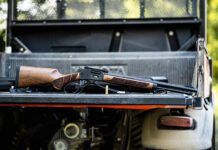Mikhail Timofeevich Kalashnikov is an impressive name for a Russian peasant who never went beyond the 9th grade. After leaving school, he went to work for the Turkistan-Siberian railway. After being drafted into the Red Army in 1938, he completed the Tank Mechanical School near Kiev. Combined with Kalasnikov’s innate intelligence, the experience he gained there enabled him to devise several improvements for armored warfare. These included a counter for the number of rounds fired from a tank’s main battery as well as a meter that recorded a tank’s running time. His inventiveness caught the attention of C.I.C. General Georgi H. Zhukov, and Kalashnikov was ordered to Leningrad where his inventions were put into practice.

With the onset of World War II and the subsequent Nazi attack on the U.S.S.R., Kalashnikov, now a Senior Sergeant and a tank commander, mixed it up fiercely with the Panzers until being seriously wounded in October of 1941. If not for this eventuality, the AK-47 might never have seen the light of day, because it was while he was hospitalized that Mikhail had the idea for a new submachine gun.
During a six-month recovery leave from the Army, Kalashnikov worked up his rough idea with some old comrades in the Turkistan-Siberian shops. The prototype went along with him to the Moscow Aviation Institute, where-in a second prototype was developed. This one was sent to the Dzerzhimski Ordnance Academy. The Academy’s top scientist didn’t think enough of the gun as it was to recommend it for military service, but he thought so highly of its inventor that he arranged for his transfer from tank commander to service with the Main Ordnance Directorate of the Red Army. There, in 1944, Kalashnikov put together an experimental model of his submachine gun. The weapon excelled in brutal and extensive competitive tests, was titled the AK-47, and was finally adopted for service with the Soviet Army in 1949.
Over the years, the AK design has been modified and modernized to become a heavy machine gun, an armored-vehicle machine gun, a light machine gun, and, more recently, a self-loading hunting carbine known as the “Saiga.” AK calibers include the 5.56 X 45 NATO, the 5.45 X 39, and the popular 7.62 X 39 (roughly 2,280 fps).
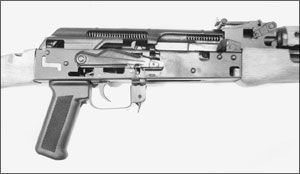
I have no idea nor will I try to guess the number of rounds that have been loosed skyward from AK-47 barrels in protests or celebrations that erupt “spontaneously” these days on a world-wide basis. I am, however, certain that all those slugs must inevitably fall back to Earth. So…heads up.
Officially, a total of over 70 million Kalashnikovs in various forms were made in Russia and in other countries under license. I say “officially,” because no one will ever know how many have been made by gun pirates. Mikhail Timofeevich Kalashnikov never patented his design (whatever he invented belonged to the State), but then patents have never stopped counterfeiters and pirates anyway.
Field Stripping an AK-47
Remove the magazine, pull the operating handle of the bolt carrier (#8) to the rear. Check the chamber, release the handle, and pull the trigger. Press the rear of the recoil-spring guide (#65) into the slot in the receiver cover (#63). Hold it inside and lift off the cover by its rear. Push the guide forward to disengage it from the receiver and barrel assembly (#62). Lift up the rear end of the guide before pulling it from the bolt carrier. Leave parts #64, 66, and 67 attached to the guide for the present.
Pull the operating handle to the rear and lift the bolt carrier upward slightly. Remove the carrier and bolt (#7) by pulling them rearward. Press the bolt into the carrier until the bolt’s operating lug can be twisted from its cam path in the carrier. Pull the bolt straight forward and out. Rotate the handguard latch (#81) upward to free the gas-cylinder tube (#80), and lift up on the rear of the handguard to remove it along with the tube.
The stock is held on by two tang screws (#82). The pistol grip (#49) employs a screw (#51) and cap (#50). Underneath the butt plate (#9) is the cover base (#11), cover (#10), cover pin (#12), and cover spring (#13). These elements serve to restrain the accessories-case spring (#1) and accessories case (#5). Within the case are the cleaning tools, consisting of a bore brush (#2), a combination tool (#3), and a jag (#4). They all attach to the rifle’s cleaning rod (#16). They should be used each time the gun has had a few rounds put through it, but they can remain in the stock as far as field stripping is concerned.
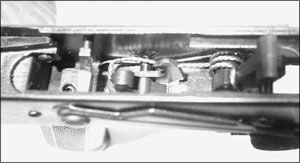
Detailed Disassembly of the Kalashnikov
The AK-47 I’m working my way through here is Romanian-made and imported by Century Arms. It is a BATF-compliant weapon inclusive of certain components, and lacking others, to allow its sale on this side of the pond (except, perhaps, in California and perhaps a few states on the East Coast). Among those “certain components” is the gas piston (#29), which is welded in place but still accessible for cleaning purposes. As you would expect, there is no bayonet mount present. I don’t know why there’s no lower handguard ferrule (#41) on this gun; perhaps it was eliminated for economic reasons by the original manufacturer.
Let’s move on. The hammer has to be in its fired position or fully forward. Insert a flat-blade screwdriver between the left side of the receiver and the receiver-pin lock spring (#56). Carefully pry the spring toward the trigger pin (#79) to release the spring from its groove in the pin. A pin punch of the same diameter as the right end of the trigger pin is used to drive the pin, smartly, from right to left. This will free up the trigger/sear (#75), disconnector (#69), and disconnector spring (#70). Before you pull out your punch, study the relationship of the parts in this assembly. What you remember will help you reinstall them, and you’ll probably want to make use of a slave pin when that time comes.
Once you’ve removed the just-mentioned parts from the top of the receiver, you’ll note that the pin-lock spring (which looks like a shepherd’s crook) is still attached to the hammer pin (#34). Get a close-in grip on the spring with a pair of needle-nose pliers, preferably of the smooth-jaw variety, to slide the shepherds’ crook forward and off the hammer pin. Tap out the pin and wiggle the hammer free of the bolt rails before removing it. More wiggling is done with the safety lever (#68) to separate it from the right-hand side of the receiver.
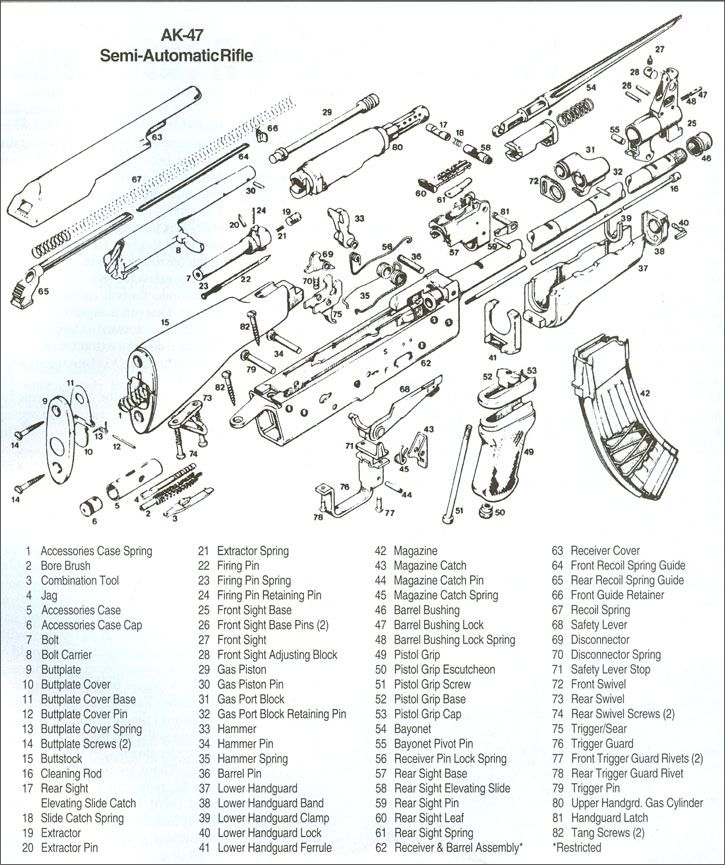
Before we go any further with disassembly, let me say a few words about this AK-47 trigger. It has a lot of take-up, but it isn’t “heavy.” Of course, “heavy” is subjective, but I’m certain as I’m sitting here before my beloved computer that you’re going to get requests for “trigger jobs.” Make them easy on yourself. Get on the internet and instruct Google, Yahoo, or your favorite search engine to bring up “AK-47 triggers.” The screen will show you a long list of choices and sources. The one that interested me the most was from DPH Arms, which included a trigger system from Tapco claiming a reduction to between 3 and 4 pounds. I can’t say whether that claim is for real, but I did make a note of the source for future reference.
Onward. The magazine-catch pin (#44) is flared, or staked, at each end. Using a good nylon or steel bench block and an appropriately sized punch, drive the pin out from either side by giving it a smart whack. Leave the punch in the hole for the moment and place a couple of fingers over the front end of the magazine catch (#43). By doing so, you’ll prevent the loss of the catch spring (#45) when you pull out the punch. Yes, you’ll probably want to use a slave pin for reassembly of the magazine-catch assembly. Once the spring and catch have been captured on the slave, you can push it out with the OEM pin—which you will not forget to restake.
Rear sight removal requires the use of a screwdriver with a 1/4-inch blade. Insert the driver in the groove in the center of the sight leaf (#60) and tap the end of the driver with a light hammer. The “ears” of the sight leaf are encased between a figure-eight-shaped cutout in the assembly, so when you tap, make the tapping in a downward and slightly rearward direction. The downward pressure will depress the rear-sight spring (#61), which holds the sight upward and into the smaller diameter of the figure-eight opening. When reinstalling the sight leaf, you have to press down on the spring and tap the rear of the sight back into the opening.
To remove the front sight, you could use the multi-purpose tool in the butt kit, though it is easier on your hand if you grind the blade off a junk screwdriver. The front-sight adjusting block (#28) can be driven out from either side, as can the barrel-bushing lock (#47), but be aware that the lock spring (#48) will have nothing to keep it in place once the lock is removed. Once the lock is out of the way, any muzzle brake present can be unscrewed. They wear a left-hand thread.
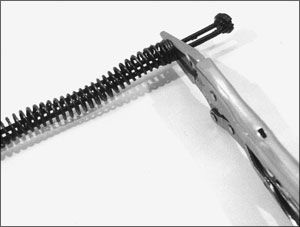
The gas system is hydraulically pressed on using a special fixture. It is tight, tight, tight. I suggest that if and when a need arises to remove/replace it, the rifle be returned to the importer—in this case, Century Arms.
Turn the bolt upside down. The widest flat on the bottom should be facing upward. The firing-pin retaining pin (#24) is located in the bolt cam. Secure the bolt cam in a padded vise and drive the pin downward. The firing pin (#22) and its spring (#23) can now be pushed out to the rear from the bolt face with a small-diameter rod or punch.
The extractor pin (#20) can be found under the bolt’s right-hand locking lug. This pin is tapered and must be drifted out toward its larger hole on the left side. The extractor (#19) and extractor spring (#21) are removed to the front.
To take down the recoil-spring assembly, lock the rear of the spring guide in your padded vise. Pull the spring back far enough to expose an inch or two of the front guide (#64) and hold it there by clamping a pair of long-nose locking pliers on the guide. The front-guide retainer (#66) can then be separated from the guide’s “double fishhook” end to complete the disassembly of the recoil-spring assembly.
Though you’ll see a hole for one, you’ll find no gas-piston pin (#30) on this AK-47. Its American-made gas piston is welded in to comply with BATF import regulations. Should it ever have to be replaced—you guessed it—the rifle goes back to the importer for another Yankee piston. Of course, you can do the job yourself—if your welding skills are up to the task and you can locate a legally acceptable gas piston. There are no such complications for removing the upper handguard (#80) from the gas cylinder. Merely lock the metal rear of the guard in your vise, grab the wood, and twist it 180 degrees.
The lower handguard band (#38) normally remains on the rifle, but occasionally its lock (#40) gets broken. If and when it does, remove the old one from left to right and stake in the replacement.




























